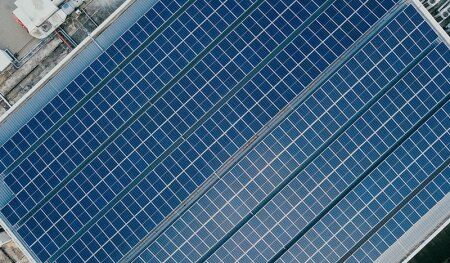Solar energy solutions provider Wunder has closed a deal with Blackstone Credit portfolio company ClearGen that will provide up to $650 million to fund solar energy systems for commercial and industrial properties.
The deal—one of the biggest investments in solar energy ever in the commercial and industrial space—aims to make inroads into a massive but underserved potential market that includes nearly 6 million buildings, according to the U.S. Energy Information Administration’s most recent survey.
“That market is defined as not residential and not utility scale, which means, basically, the whole of the commercial industrial real estate market is in scope,” Wunder CEO Dave Riess explains.
Having up to $650 million to work with gives Wunder the potential to make further inroads in that segment.
Michelle Davis, principal analyst for U.S. distributed solar at Wood Mackenzie Power & Renewables in Tempe, Arizona, says that the Wunder deal with ClearGen is several times larger than typical investments in commercial and industrial solar.
“I can’t say this is the biggest, but it’s definitely up there,” says Davis, who estimates that only about 5 percent of commercial and industrial buildings in the United States are outfitted with solar panels, usually on rooftops.
Tapping into that market opportunity—basically, almost everything larger than a private residence and smaller than a utility-scale solar energy facility—has not been easy. While some of the biggest U.S. property owners have pushed ahead with installing solar panels, many of the structures are owned by companies that aren’t big enough to have access to investment-grade credit.
“There’s a long tail of commercial and industrial companies in the U.S. that may have only a couple of locations, maybe even one,” says Davis. “They might have a fantastic rooftop for solar, but that doesn’t mean that they will pass through all the hoops that a typical investor needs, in order to put up the capital for a large solar project.”
Building Owners Can Lease Rooftops, or Own Solar Systems
Many of those buildings also require unique, bespoke solar installations, rather than one-size-fits-all solutions. That’s made it more difficult to assemble large portfolios of commercial and industrial solar projects to attract investors.
“There are lots of different transaction archetypes in that market, but one of the factors they all share is that the sort of system sizes represent capital investments of less than half a million dollars,” Riess says. “In order to really access these opportunities as a large scale, one needs to be able to transact really, really cost-effectively. Access to capital is one factor, but the other is delivering a really compelling value proposition to the commercial real estate owner or stakeholder.”
Wunder has worked to develop a business model that overcomes those obstacles and allows it to go after opportunities at various scales. The company started out eight years ago primarily as a provider of financing for commercial and industrial solar projects, but eventually evolved into a full-fledged solar developer that owns and operates the arrays, for which it leases rooftop space from building owners. For those who want to own their solar assets, Wunder also will design and engineer systems and tapping into its nationwide network of installers to build them.
Whether or not a client chooses to own a solar system or simply allow its rooftop to be utilized often is dictated by whether it can use federal tax credits for solar energy. A real estate investment trust (REIT), for example, often doesn’t have enough tax liability to use the credit across the entirety of its portfolio, and owning a system and generating revenue from the electricity might affect the a REIT’s tax-advantaged status. But Wunder leases the roof and retains control of the solar system, “that’s just more lease revenue,” Riess explains.
Wunder was an attractive choice for ClearGen, which invests in various on-site renewable energy projects for commercial, industrial, and institutional energy consumers, because of low transaction costs that enable it to have high deal velocity, according to ClearGen CEO Rob Howard. “They have a great track record,” Howard says.
Monetizing Rooftops and Achieving Environmental Goals
Monika Henn, director of the ULI Greenprint Center for Building Performance, says that the Wunder-ClearGen deal is an indication of the opportunity for renewable energy that increasingly is available in the commercial and industrial real estate market.
There’s a lot more interest these days from the commercial real estate industry, when it comes to implementing on-site solar,” Henn says.
“There needs to be a framework of different financing solutions available,” Henn says, adding that which deal structure works best may vary from company to company and even from building to building.
Henn says that property owners’ motivations for implementing solar energy can vary. Some are attracted by the idea of monetizing their rooftops, while others are interested in using on-site solar to reduce their own energy costs. Increasingly, companies also see solar energy systems as a way to help achieve environmental-sustainability-governance (ESG) goals.
“A lot of the people I’ve talked to have said, ‘We looked at a solar deal a few years ago, and it wasn’t right for us then, but that same deal makes sense now because we have these new sustainability goals and so do our clients,’” Henn explains.
Other companies either are trying to comply with building performance standards that municipalities increasingly are imposing, or else hope to “future-proof” their properties against anticipated regulations, Henn says.
Henn says that for many companies, implementing solar power is part of a larger shift toward sustainability and emphasizing ESG principles. “It’s not just, do I have solar on the roof?” Henn says. “It’s ‘Do I have a really efficient building?’ Renewable energy is one piece, part of the pathway toward achieving net-zero carbon emissions or a more sustainable building.”
Other Industry Players are Investing in Solar As Well
The Wunder-ClearGen deal is one of numerous indications of the real estate industry’s increasing interest in solar in recent years.
Logistics real estate leader Prologis, for example, placed eighth among companies--slightly ahead of social media giant Facebook—and first among real estate companies in overall commercial solar capacity in the Solar Energy Industries Association’s 2019 ranking of businesses and corporate brands who’ve installed solar capacity, according to a Prologis press release.
Another real estate company that’s invested in solar capacity is Kimco Realty Corp., one of North America’s largest publicly traded owners and operators of open-air grocery-anchored shopping centers. In January 2021, Kimco announced that it had initiated five new solar projects on its properties, including solar panels on the roof of its new headquarters building in Jericho, Long Island, as well as systems at three shopping centers on Staten Island and a fifth in Massachusetts. Those projects aim to provide an estimated 4.64 million KWh of electricity each year, enough to power 600 homes.
Hudson Pacific, another solar energy leader, operates EPIC, a Class A creative office tower in Hollywood, which features solar panels installed on the façade, according to the company’s website.
Other major real estate companies have made similar solar power purchase agreements (PPAs), in which they host a solar developer who operates the system, and agree to purchase power from it. In March, real estate developer Trammell Crow and solar company Altus Power agreed to a $600 million deal to install solar panels on 35 million square feet (3,251,606 square m ) of industrial property in 19 different markets by 2026, as well as making additional investments in battery storage, charging stations for electric vehicles and other technology, according to the Wall Street Journal. Altus will lease the space and then sell the electricity that it generates, mostly to Trammell tenants at a discount, the newspaper reported.
Similarly, Boston Properties has executed 12 online solar PPA agreements, and Digital Realty, a major developer of data centers, also has numerous solar PPAs.
PATRICK J. KIGER is a Washington, D.C.–based journalist and author.






